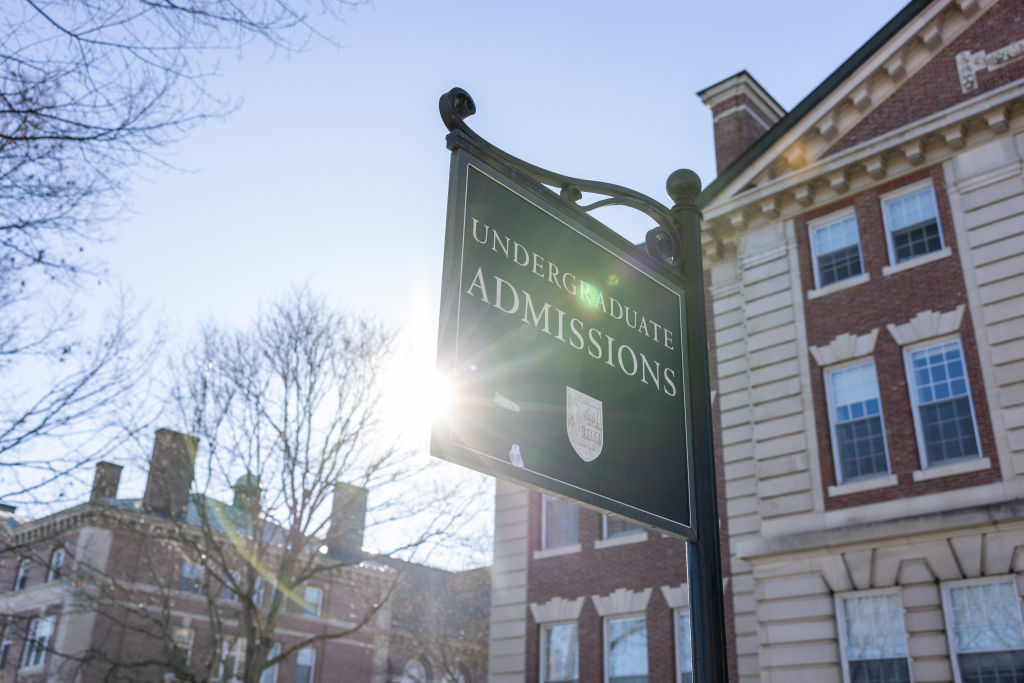
At America’s wealthiest colleges, the SAT is back with a vengeance, and it’s easy enough to see who will suffer: socioeconomically disadvantaged students of color.
Over the past few weeks, Dartmouth, Yale, Brown, and Harvard have all announced that they will require standardized test scores from all applicants next fall after suspending their use during the pandemic.
Between the spring of 2020 and the winter of 2021, the number of four-year universities and colleges with test-optional policies doubled from 713 to 1,350 including, notably, all eight Ivy League schools. Colleges touted the shift as progressive. “Students have never been treated as numbers,” Colorado College posted on its website. “Our test-optional policy allows our team to identify the most qualified candidates for admission while also increasing access for first-generation, low-income, and traditionally underserved students.” Even Harvard was on board. “People somehow think that if you don’t have test scores it’s very hard to evaluate an application, but you have teacher reports, you have grades,” Harvard’s admissions dean Bill Fitzsimmons said in 2022. “There’s an enormous amount of academic information.”
In the wake of the Supreme Court’s decision in SFFA v. Harvard, which effectively ended race-based affirmative action, it was possible to envision career-defining standardized testing heading for the scrap bin of history, too. After all, the SAT and ACT have long been known to correlate closely with wealth. One recent study found that students from families in the top 1% of the income distribution are 13 times more likely than students from the bottom 20 percent to score 1300 or higher on the SAT. Just 2.5% of students from the lowest income quintile manage to reach 1300.
If colleges wanted to preserve diversity—and could no longer consider an applicant’s race—surely they could no longer place great weight on a metric that functions principally as a marker of the applicant’s wealth.
Not so fast.
Elite colleges are whistling quite a different tune than they were just two years ago. The reimplementation of standardized testing has coincided with a spate of personal anecdotes, research, and articles extolling their putative benefits. Christina Paxson, the president of Brown University, recently touted the SAT and ACT for revealing “useful information about whether students will, on average, be academically successful at Brown.”
Read More: I Took the SAT Again in My 50s. Turns Out I Had Learned Nothing
One could understand the need for standardized testing at public colleges, where more than a third of entering students fail to graduate within six years. But it’s a curious argument to be advanced by Brown, where the six-year graduation rate is 96% and for Pell Grant recipients is 93%.
Another line of defense is that the SAT is the best friend of the downtrodden. Harvard economist David Deming said, “My worry is that if we get rid of the SAT, you’re getting rid of the only way that a low-income student who’s academically talented has to distinguish themselves.” It’s again a curious argument to be made, especially by schools like Brown and Harvard, each of which counts itself among the 38 American colleges where more students come from families in the top 1% of the income distribution than the bottom 60%. This is true even though Brown has an endowment of $6.6 billion and Harvard the nation’s largest—$50.9 billion.
It's even more curious, still, given that in the same letter in which Paxson announced the return to standardized testing, she reaffirmed Brown’s commitment to early decision—which has long been known to hurt poorer students who can’t afford to commit to a college without comparing financial aid packages—and to the preference it affords to the children, of alumni, donors, faculty, staff, and athletic recruits—pathways that overwhelmingly benefit rich, white applicants, otherwise known as “ALDC” applicants. At Harvard, for example, 43% of white students are “ALDC.” Research shows that about three quarters of these students would have been rejected without their ALDC status.
Read More: The Case Against Private College Admissions Counselors
So what’s really going on?
To understand, one need only take a closer look at the most widely cited study by Deming and his colleagues Raj Chetty and John Friedman. Standardized test scores, the story goes, are a much better predictor of college success than high school GPA. What are their principal markers of “college success?” Attending an “elite graduate school” and “working at a prestigious firm.” The outcome they’re looking at is the accumulation of wealth not knowledge. Is it any surprise that rich kids both outperform lower-SES kids on the SAT and at getting investment banking jobs at Goldman Sachs and consulting jobs at McKinsey?
What if these researchers and college administrators instead adopted this definition of success: the student maintained a college GPA of over 3.0, learned and grew as a person, and got a significant benefit in terms of economic mobility? By this standard, virtually every socioeconomically disadvantaged kid admitted to one of these prestigious, highly endowed colleges is a success.
But this interpretation of the data and definition of the object of college would be decidedly inconvenient and mask the true object of elite colleges: to make rich kids richer.
More Must-Reads from TIME
- Cybersecurity Experts Are Sounding the Alarm on DOGE
- Meet the 2025 Women of the Year
- The Harsh Truth About Disability Inclusion
- Why Do More Young Adults Have Cancer?
- Colman Domingo Leads With Radical Love
- How to Get Better at Doing Things Alone
- Michelle Zauner Stares Down the Darkness
Contact us at letters@time.com